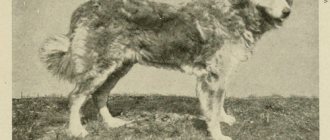One breed is divided into three varieties: smooth-haired, wire-haired (considered close relatives) and toy fox terrier.
These dogs are hardy, physically developed and friendly. With good care they live over 15 years.
Breed characteristics
| Short description | |
| Origin: | England |
| Conditions of detention: | In an apartment, in a house |
| Purpose: | Companion dog, hunting dog |
| Color: | Tricolor (black and tan spots on a white background) |
| Wool length: | Short coat for smooth coats and medium wiry coat for wire coats |
| Adult dog size: | Height at withers – 35-40 cm, weight – up to 8 kg |
| Average life expectancy: | 12-15 years |
| Walk: | Daily long |
| Physical activity needs: | Average physical activity needs (walking 1 to 3 hours per day) |
| Fédération Cynologique Internationale (FIC) classification: | Group No. 3 terriers, section No. 1 large and medium terriers |
| Puppy price: | From 10,000 rubles - purebred pet-class puppies, from 20,000 rubles - show-class puppies, the price for babies from titled champion parents can reach 50 - 60 thousand rubles |
Price for fox terriers
Prices for fox terriers directly depend on their pedigree. If you need a dog that will simply keep you and your family company, then its cost will start from fifteen thousand rubles. A puppy from working parents will cost more. And if he had champions in his family, get ready to pay from twenty-five to thirty-five thousand rubles for such a dog.
You can also find an adult dog. Their cost will be relatively low (from seventeen thousand rubles). But there is a big risk that the dog will not take root with you. This breed becomes very attached to one owner. Therefore, any moving is undesirable for her.
History of the origin of the species
Fox Terriers began to be bred in England for a specific purpose - to hunt foxes in holes. Hence the name of the breed - “ fox ” translated from English as “ fox ”, “ terra ” - earth in Latin.
Written references to the ancestors of the Foxes date back to the 11th century. The first famous lover of the breed to engage in its targeted selection was Count Montey. He paid special attention primarily to the working qualities of dogs, and not to their exterior. After some time, breeders began to care about the appearance of the fox terrier. In order to get it in its modern version, the ancestors of Foxes crossed with bull terriers, hounds, spaniels, dachshunds and beagles. The main task was to preserve the authenticity of the breed and improve its merits.
Fox terriers gained popularity at the end of the 18th century. It was at this time that fox hunting became extremely widespread throughout Great Britain and became a national sport. Foxes became an integral part of this entertainment; they helped hunters by driving foxes out of their holes.
At this time, breeders turned to questions of dog color . A desire began for the predominance of white in the coloring of dogs in order to make pets as different as possible from bright foxes jumping out of holes, and to reduce the chance of accidentally shooting a fox terrier instead of prey. All large individuals were also rejected, since their wide chest prevented them from crawling into the narrow passages of the burrows.
In the 19th century, the breed was finally formed in its modern form.
These dogs were presented at the exhibition for the first time in 1859. The first monobreed show, with almost 200 participants, took place already in 1886.
At the same time, Fox Terriers began to be divided into two separate breeds - smooth-haired and wire-haired, but the breed standard was still the same. Moreover, until the 20th century, the main population consisted of smooth-haired individuals, but today lovers of the breed increasingly prefer wire-haired dogs.
At the end of the 19th century, representatives of the breed began to be actively exported outside of England throughout Europe and to Russia.
Although the first fox terrier came to the territory of our country much earlier. The puppy was brought to St. Petersburg in the 60s of the 19th century as a gift to Prince Golitsyn . He is considered the first Russian Fox fan in Russia.
Distinctive features
The FCI makes a clear distinction between smooth and wire fox terriers. However, the difference in the breed standard is essentially only in the description of the dogs' coat.
Thus, in wire-haired dogs, the most rigid, wiry-like coat is welcomed . The hair is dense, medium length. Slightly longer on the back and legs than on the whole body. A kind of beard is formed on the muzzle, which gives the muzzle an unusual expression and rectangular shape.
Wire Fox Terrier
Read the detailed article: “Wire Fox Terrier - friendliness, enthusiasm and fearlessness in one dog.”
Smooth-haired cats have dense, short fur. The same throughout the body, only a little shorter on the muzzle and paws.
Smooth Fox Terrier
Otherwise the breed standard is similar:
- The body is strong and muscular, tends to square proportions (the length of the body is equal to its height);
- The body is narrow, seems light and taut like a spring;
- The head is flat, tapering towards the nose; the transition from the top of the head to the nose is almost invisible;
- Cheekbones are narrow;
- bite ;
- The jaws are strong with a full set of teeth;
- The eyes are round and dark;
- The ears are small, triangle-shaped; stand upright, but the tips are slightly lowered forward;
- The chest is narrow;
- The stomach is tucked;
- The legs are straight and strong with pronounced muscles;
- color - red and black spots on a white background; less common is two-color (according to the standard it is also acceptable, but not so loved by breeders) - white with red or brown spots;
- The tail is set as high as possible and looks upward; most often stopped; has rare strength (it can be used to pull and lift the dog if necessary). The Fox Terrier does not wag its tail like other breeds. He makes short movements, as if he is shaking.
The weight of dogs ranges from 6 to 8 kg , females weigh slightly less. The height of the dog at the withers is from 35 to 40 cm.
Photo of an adult dog
Smooth Fox Terrier
Wire Fox Terrier
Photos of puppies
Features of character and behavior
Each breed of dog has its own characteristics of behavior and character. The Fox Terrier is no exception; its temperament has both pros and cons.
Advantages
- The Fox Terrier is incredibly energetic. It is suitable for active people who love walks in the fresh air and active recreation.
- Fox will easily endure any trip accompanied by his owner. For families with children, this breed is a godsend. The dog will happily frolic with children of any age, and will also patiently tolerate and support the pranks of the youngest family members.
- The Fox Terrier is friendly, playful, hardy and easy-going. He is ready to tirelessly be the center of attention of the whole family around the clock.
- These dogs are quite good-natured towards strangers. But at the first sign of aggression, the pet will rush to defend itself or its owner.
Flaws
This breed is not suitable for homebodies or workaholics; in the absence of the owner, the pet will develop blues, and over time, signs of disobedience.
This is a dog that needs to be given quite a lot of time and attention.
It is possible to keep a Fox Terrier in the same territory with another dog, despite the jealousy inherent in the breed. But if there are cats, parrots and rodents in the house, buying such a dog is definitely not the best idea. The rest of the pets will be in constant danger of becoming prey, because Foxes have a very well developed natural hunting instinct.
This breed has a loud character and the pet often barks for various reasons. When kept in an apartment, this can lead to conflicts with neighbors.
Fox Terrier Health
Basically, fox terriers “do not complain” about their health. This is not a sickly breed of dog. But, like all other dogs, Foxes are prone to some genetic diseases. It is important to choose a healthy puppy with a good pedigree. Otherwise, you risk becoming frequent guests of veterinary clinics.
The most common diseases of fox terriers include:
- diabetes;
- Peters disease, when blood circulation in the hip joint deteriorates, causing necrotic damage;
- ophthalmological diseases, including distichiasis;
- partial deafness, which may become complete over time;
- epilepsy;
- myasthenia gravis.
Many fox terriers suffer from allergic reactions to certain components of the diet. They may develop and progress inflammatory processes in the body. Therefore, it is necessary to introduce a new diet extremely carefully, in small portions. Don't forget about the mandatory vaccinations that your dog needs to get according to plan.
Care and maintenance
Fox Terriers are not large in size or shed heavily, which is why they feel great both in a house with adjacent territory and in a small city apartment.
Basic dog care will not take much time:
- Trimming nails as needed;
- Examination and rubbing of eyes;
- Timely cleaning of ears and teeth.
Nutrition
Nutrition is an important aspect of caring for these dogs . Overeating is dangerous for them. Therefore, you need to calculate portions not only based on the size of the pet, but also on its activity level.
You can feed your Fox Terrier both dry food and natural food. In any case, veterinarians never tire of repeating that a dog’s diet should be balanced. That is, if it is a dry mixture, you need to choose a holistic, super-premium or premium class. Before purchasing, it is better to read reviews and study the composition of the food, and also check with a consultant in the store whether this option is suitable for the breed.
When choosing natural food, your pet needs to create a high-quality, complete diet. Feeding table scraps to your dog is strictly prohibited!
Recommended products for Fox:
- Raw (frozen or scalded with boiling water) or lightly cooked lean meat;
- Boiled offal (liver, heart);
- Sea fish with bones removed;
- Cottage cheese, kefir;
- Vegetables;
- Cereals (buckwheat, rice, oatmeal);
- Fruits other than citrus fruits;
- A little greenery.
It is strictly forbidden to feed your pets fried, flour, sweet, smoked, peppered and fatty foods.
When buying a small puppy, the emphasis in the diet is on fermented milk products and cereals . A two-month-old puppy is fed 6 times a day at regular intervals. Then gradually reduce the number of servings from 6 to 2 per day, and also reduce the amount of fermented milk products, replacing them with meat. Adult Foxes from the age of one are fed twice a day .
As activity decreases, the portion size should also be reduced to avoid excess weight gain.
We recommend that you read a detailed article on the topic: “How and what to feed a dog: types and characteristics of nutrition.”
Health
Fox Terriers are real long-livers . With proper care, they live more than 15 years. However, for such a result it is necessary to know the diseases to which the breed is predisposed, to be able to prevent them or to notice and treat them in time.
Vaccinations
Proper and timely vaccination is also the key to your pet’s health.
- For the first vaccination at 6-8 weeks, you need to treat the animal with all parasites (external and internal) in advance - 10-14 days before going to the doctor. At your appointment, your veterinarian will explain what medications are on the market and how they differ.
- Most often they recommend Biovac, Kanigen, Nobivak or Eurikan. The cost of the vaccine will depend on the chosen medicine (from 200 to 2,000 rubles).
- At 12 weeks a booster vaccination is required.
- Then the vaccine is given 6-7 months after the change of baby teeth to molars.
- At 12 months, another vaccination is given - against diseases (distemper, enteritis, parainfluenza and others) and against rabies.
Sometimes veterinarians advise vaccinating your pet against rabies at an earlier age. Only the owner decides whether to do this or not. After each vaccination, the dog will feel a little stressed and will be more lethargic than usual for a day or two.
Also, for 10-14 days, you should not give her heavy physical activity or take her out into large crowds of people or animals.
Important article on the topic: “Everything you need to know about dog vaccinations.”
Diseases
Fox Terriers have good genetics, but there are several diseases that this breed is prone to:
- Dysplasia and other joint problems. This manifests itself mainly in adulthood and is a consequence of too much activity of the pet.
- Eye diseases (cataracts, melanoma, glaucoma). These are manifestations of heredity in most cases. In this case, there are no preventive measures other than close observation and examinations by a doctor.
- Diabetes, obesity, gastrointestinal dysfunction. These problems are associated with poor nutrition. With a nutritious diet, owners will be able to avoid them.
Walk
Fox Terriers need long daily walks. Moreover, these should not be easy walks in the park, but an active pastime. Running, games, agility - all this is welcome.
Foxes are very playful, so a ball, frisbee or a simple stick will be great entertainment for them . It is also recommended to socialize them from a young age and take them out to playgrounds with other dogs. In puppyhood, fox terriers will easily get used to communicating with their own kind and will play with them with pleasure.
Residents of houses with adjacent territories are highly discouraged from simply letting their dogs out into the yard. They love to dig holes. The appearance of the lawn and any flower bed will be ruined if you leave your pet alone without supervision.
Grooming
There is no pronounced seasonal shedding in Foxes due to the lack of undercoat.
- However, smooth fox terriers require much less grooming - a simple brushing with a soft-bristled brush once a week is sufficient.
- Wire-haired dogs require a more careful approach - they need to be brushed with a stiff comb at least 2 times a week to avoid matting.
- Pets need to be trimmed several times a year to remove dead hair. If this is not done, various dermatological problems may appear.
Decorative haircuts are highly not recommended either for show dogs or for pets for the hobby. Any haircut can ruin not only the authentic appearance, but also the quality of the coat.
Bathing with shampoos should also be reduced to a minimum.
Feeding recommendations
To raise a healthy and active fox terrier, from an early age it is necessary to provide the puppy with proper feeding, the basis of which is a balanced diet of nutrients and energy. For puppies, it is better to use food containing components to strengthen the immune system and maintain the functioning of the gastrointestinal tract. This food is Purina® PRO PLAN® Small & Mini Puppy dry complete food with OPTISTART® complex for puppies of small and toy breeds.
It is recommended that adult Fox Terriers be fed Purina® PRO PLAN® Small & Mini Adult complete dry food with OPTIBALANCE® Complex to maintain the dog's overall health in excellent condition.
Mating
To successfully breed a pet, you need to follow some rules:
- The age for breeding a fox terrier is no earlier than 18 months ;
- Females can be mated no more than once a year , so she will have time to restore her body;
- After reaching the age of seven, breeding dogs is strictly prohibited.
For assistance in the correct selection of a pair and the mating process, it is recommended to contact the nursery where the dog was purchased. Professional breeders will give valuable advice and warnings to the Fox Terrier owner, and will also help in finding a match for the dog.
Before mating, it is advisable for the couple to take a good walk together to allow the dogs to get used to each other and it is advisable not to feed both of them the day before.
It is better to conduct acquaintance in advance on neutral territory. The mating itself is done only on the male's territory . It is better to obtain more detailed information on mating, pregnancy and childbirth from experienced breeders who have been dealing with the breed for a long time.
Read a detailed article on the topic: “Everything you need to know about breeding dogs: appropriate age, what to do if it doesn’t work out, rules and advice from breeders.”
Disease susceptibility
Fox Terriers are in good health, but sometimes have a predisposition to the development of avascular necrosis of the femoral head, luxation of the kneecaps, myasthenia gravis, epilepsy, and coagulopathy.
Older animals are prone to hypothyroidism, diabetes mellitus, endocardiosis, tartar formation, and the development of cataracts.
Compliance with the rules for keeping fox terriers and constant veterinary preventive examinations will help reduce the risk of developing many diseases.
Key points in training
Training fox terriers is generally easy. These dogs are smart and quickly understand what their owner wants from them.
However, there are several points that can overshadow the classes:
- Foxes are easily distracted. This means that the owner will have to put in quite a lot of effort to keep the dog's attention and concentrate on learning the commands. Professional trainers advise building lessons in the form of a game and bringing along as many treats as possible to keep the dog motivated throughout the training. It is better to start training individually; after a basic study of the basic commands, you can move on to group classes with other dogs.
- Fox Terriers often display dominance . Even a novice dog breeder can handle raising this breed, but to do this he will have to show a sufficient amount of patience, firmness and rigor. All actions must be consistent, and the owner must be a firm leader and not allow the dog to take over the situation.
- Zero tolerance for violence . Physical punishment of these dogs is highly discouraged. Not only can a fox terrier snap at its owner even when pain appears, but obedience in this situation will not be obtained from it. The dog will lose trust in its owner and harbor a grudge.
Read about how to properly train a dog in the article: “Training a puppy: effective methods from dog handlers, learning commands at home.”
If the owner is not sure that he can independently cope with the character of the Fox, it is better to conduct classes under the supervision of an instructor who will give instructions and advice on how best to structure the training and how to behave with the dog.
How to choose a puppy
Choosing a puppy is a very responsible matter.
Buying a baby fox terrier from an advert is highly not recommended. It is better to contact a nursery that specializes in this breed. There are quite a lot of Fox breeders both in the capital and in the regions, so the search will not take much time.
When choosing a baby, you don’t need to be embarrassed to ask questions or rush. You need to watch the puppy, carefully examine him, double-check all documents and look at the parents.
The cost of a puppy varies depending on its quality, the fame of the kennel and the title of the parents. Show-class babies are sold at prices ranging from 20,000 rubles and above . You can buy a pet-class puppy cheaper.
Nicknames
When choosing a name, be guided by the fact that it will have to be pronounced many times daily. Therefore, short and sonorous nicknames are preferred. This could be the name of your favorite historical or literary character, favorite singer or actor.
If you are lost in the choice or simply do not have imagination, refer to special lists of names.
Examples of nicknames for girls: Jessie, Gerda, Kira, Linda, Masha, Inga, Vesta, Dina, Bertha, Casey.
Examples of nicknames for boys: Athos, Pirate, Demon, Cupid, Richie, Storm, Prince, Marat, Chris, Faust.
Reference! To make sure your dog remembers the name easily, don’t come up with a word that’s too long. A name with two or three syllables will be the best option.











